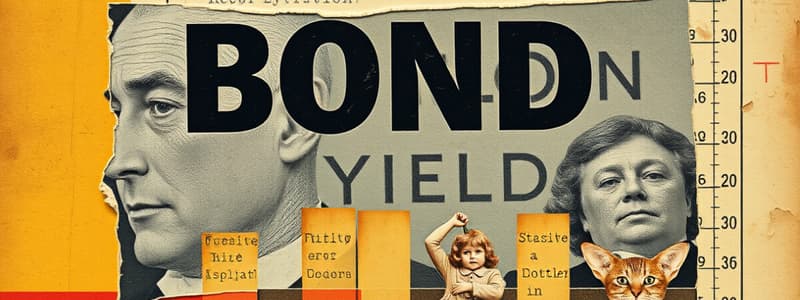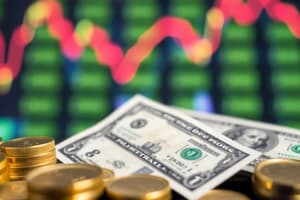Podcast
Questions and Answers
What primarily determines the yield of a bond?
What primarily determines the yield of a bond?
- The issuer's credit rating
- The marketplace conditions (correct)
- The coupon rate of the bond
- The maturity date of the bond
How often do most bonds typically pay interest?
How often do most bonds typically pay interest?
- Semi-annually (correct)
- Monthly
- Quarterly
- Annually
Which of the following describes the relationship between discount rate and yield?
Which of the following describes the relationship between discount rate and yield?
- Yield is calculated without considering the discount rate
- Yield can sometimes be lower than the discount rate
- Discount rate and yield are the same thing (correct)
- Discount rate is always lower than yield
What value does the coupon rate determine?
What value does the coupon rate determine?
If a bond’s coupon rate is 9% and it pays interest twice a year, what is the amount of each coupon payment?
If a bond’s coupon rate is 9% and it pays interest twice a year, what is the amount of each coupon payment?
When calculating the fair price of a bond, which of the following needs to be considered?
When calculating the fair price of a bond, which of the following needs to be considered?
What adjustment is necessary when bonds pay interest more than once a year?
What adjustment is necessary when bonds pay interest more than once a year?
What is meant by a 'spread in basis points' in the context of yield?
What is meant by a 'spread in basis points' in the context of yield?
What is the formula used to calculate a single coupon payment if the bond has a nominal value of $100 and a coupon rate of 9%?
What is the formula used to calculate a single coupon payment if the bond has a nominal value of $100 and a coupon rate of 9%?
How does a bond's coupon rate affect its price volatility compared to bonds of the same maturity?
How does a bond's coupon rate affect its price volatility compared to bonds of the same maturity?
What is primarily affected by a bond's duration?
What is primarily affected by a bond's duration?
Given two bonds with the same coupon rate, how does the term to maturity affect their price volatility?
Given two bonds with the same coupon rate, how does the term to maturity affect their price volatility?
What is the impact of interest rate changes on different bond prices?
What is the impact of interest rate changes on different bond prices?
What does a higher duration indicate about a bond?
What does a higher duration indicate about a bond?
What factors can be compared when evaluating bonds with different coupon rates and maturities?
What factors can be compared when evaluating bonds with different coupon rates and maturities?
Under which condition will current yield, approximate YTM, and YTM be equal?
Under which condition will current yield, approximate YTM, and YTM be equal?
What risk arises when coupon payments may earn a lower return than the bond's YTM at purchase?
What risk arises when coupon payments may earn a lower return than the bond's YTM at purchase?
How does fluctuating interest rates affect reinvestment of coupon payments?
How does fluctuating interest rates affect reinvestment of coupon payments?
Which bond type has no reinvestment risk?
Which bond type has no reinvestment risk?
What happens if coupon payments are reinvested at higher rates than the bond’s YTM at the time of purchase?
What happens if coupon payments are reinvested at higher rates than the bond’s YTM at the time of purchase?
What could potentially overstate the YTM at the time the bond was purchased?
What could potentially overstate the YTM at the time the bond was purchased?
What does the term 'YTM' stand for?
What does the term 'YTM' stand for?
When is it likely that interest rates will not remain constant over the bond's term?
When is it likely that interest rates will not remain constant over the bond's term?
What is the main concern during a fluctuating interest rate environment for bond investors?
What is the main concern during a fluctuating interest rate environment for bond investors?
What effect does purchasing a bond at a discount have on its reinvestment risk?
What effect does purchasing a bond at a discount have on its reinvestment risk?
What is the fair price of a bond at a discount rate of 10%?
What is the fair price of a bond at a discount rate of 10%?
How is the yield on a Treasury bill calculated?
How is the yield on a Treasury bill calculated?
What aspect does current yield focus on for an investment?
What aspect does current yield focus on for an investment?
In the given formula for T-bill yield, what does the term 'Term' represent?
In the given formula for T-bill yield, what does the term 'Term' represent?
Which of the following is a key characteristic of Treasury bills?
Which of the following is a key characteristic of Treasury bills?
What is the calculated yield on an 89-day T-bill purchased for a price of 99.5?
What is the calculated yield on an 89-day T-bill purchased for a price of 99.5?
What does the sum of the present value of a bond's principal and its coupons represent?
What does the sum of the present value of a bond's principal and its coupons represent?
Which of the following is NOT true about the current yield of an investment?
Which of the following is NOT true about the current yield of an investment?
What happens to the yield of a T-bill if its purchase price increases?
What happens to the yield of a T-bill if its purchase price increases?
Which of the following accurately defines a T-bill's earnings for tax purposes?
Which of the following accurately defines a T-bill's earnings for tax purposes?
What is the main reason that bond prices are more volatile at lower interest rates?
What is the main reason that bond prices are more volatile at lower interest rates?
A yield change from 4% to 2% has what percentage change compared to a yield change from 12% to 10%?
A yield change from 4% to 2% has what percentage change compared to a yield change from 12% to 10%?
What occurs to a bond's price when its yield decreases by 1%?
What occurs to a bond's price when its yield decreases by 1%?
How much does the price of a bond change when the yield increases from 3% to 4% according to the information provided?
How much does the price of a bond change when the yield increases from 3% to 4% according to the information provided?
What is the relationship between interest rates and bond prices?
What is the relationship between interest rates and bond prices?
Which of the following best illustrates the concept of absolute vs. relative yield change?
Which of the following best illustrates the concept of absolute vs. relative yield change?
In the provided table, what is the price of a 3% bond when the yield is at 2%?
In the provided table, what is the price of a 3% bond when the yield is at 2%?
What effect does a 1% decrease in yield have on a bond's price in comparison to a 1% increase?
What effect does a 1% decrease in yield have on a bond's price in comparison to a 1% increase?
What is the price change when the yield of a bond decreases to 2% from 3%?
What is the price change when the yield of a bond decreases to 2% from 3%?
What is the relative yield change when a bond's yield drops from 12% to 10%?
What is the relative yield change when a bond's yield drops from 12% to 10%?
How does a 1% decrease in yield impact a bond's price compared to a 1% increase?
How does a 1% decrease in yield impact a bond's price compared to a 1% increase?
When does a bond's price exhibit greater volatility?
When does a bond's price exhibit greater volatility?
What is the percentage change in price when the yield decreases from 3% to 2%?
What is the percentage change in price when the yield decreases from 3% to 2%?
Which statement about yield changes is true?
Which statement about yield changes is true?
What is the correct price of a bond priced at $100 when the yield is at 3%?
What is the correct price of a bond priced at $100 when the yield is at 3%?
What happens to bond prices as interest rates rise?
What happens to bond prices as interest rates rise?
What is the price change percentage when the yield increases from 3% to 4%?
What is the price change percentage when the yield increases from 3% to 4%?
In the context of bond valuation, why is relative yield change more significant than absolute yield change?
In the context of bond valuation, why is relative yield change more significant than absolute yield change?
Flashcards are hidden until you start studying
Study Notes
Yields and Pricing Bonds
- Yields fluctuate based on market conditions and are typically compared to Government of Canada bonds for similar terms.
- Yield often equals the discount rate, which should not be confused with the fixed coupon rate determined at bond issuance.
- Coupon payments reflect interest paid to bondholders, adjusted for payment frequency: e.g., an annual coupon of 9% for a bond will yield $4.50 per semi-annual period.
Fair Price of a Bond
- A bond's fair price equals the present value of its principal plus the present value of future coupon payments.
- For a bond at a discount rate of 10%, the present value totals around $96.77, combining both coupon and principal values.
Treasury Bills (T-bills)
- T-bills are short-term securities sold at a discount and do not pay interim interest; returns come from the difference between purchase price and maturity value.
- Yield for T-bills can be calculated using the formula: ((100 - Price) \div Price \times \frac{365}{Term} \times 100).
Current Yield
- Current yield focuses on current cash flows relative to the market price, rather than original investment amounts.
- If a bond is trading at par, the current yield, approximate Yield to Maturity (YTM), and YTM will align.
Reinvestment Risk
- YTM estimates return but can differ if future market interest rates fluctuate; reinvestment risk arises from potential lower rates at which coupons are reinvested.
- Zero-coupon bonds have no reinvestment risk, as they don’t pay coupon cash flows before maturity.
Impact of Yield Changes
- Relative yield changes affect bond prices more significantly than absolute changes; a drop from 12% to 10% (17% decrease) impacts prices less than a drop from 4% to 2% (50% decrease).
- Price reactions vary: a 1% yield drop results in a larger price increase than a 1% yield rise.
Duration and Price Volatility
- Bond prices inversely change with interest rates: rising rates decrease prices while falling rates increase them.
- Bonds with higher coupons are less price volatile than those with lower coupons, while longer-term bonds are more volatile than shorter-term ones.
- Duration measures bond price sensitivity to interest rate changes: a higher duration indicates greater price reaction for each 1% interest change, helping assess volatility in investment decisions.
Studying That Suits You
Use AI to generate personalized quizzes and flashcards to suit your learning preferences.


